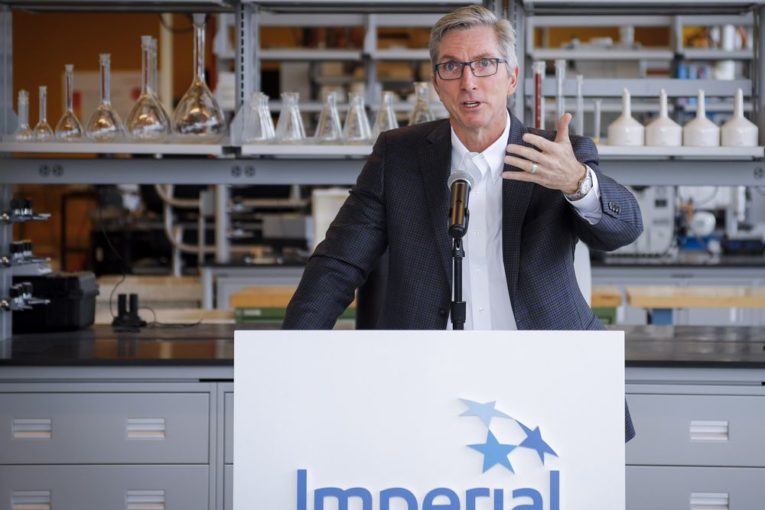
Imperial Oil CEO Rich Kruger warned weeks ago that if the province restricted oil production in Alberta, the company would re-evaluate the future of its new $2.6-billion oilsands project.
It wasn’t an idle threat.
The country’s largest integrated oil producer declared Friday it will slow the pace of work this year on the Aspen thermal oilsands development northeast of Fort McMurray, likely delaying for at least 12 months its original 2022 startup plan.
Imperial cited “market uncertainty stemming from Alberta government intervention,” along with other competitiveness issues, for the decision.
It’s no secret the Calgary-based company fiercely opposed the province mandating oil production cuts this year.
Ramping down a major growth project isn’t simply idle talk or lofty rhetoric.
It’s a big-budget decision.
One quick way to get government’s attention is to yank spending off the table.
It also lets those at the Alberta legislature know it’s serious, and wants curtailment wound down as quickly as possible.
“We cannot invest billions of dollars on behalf of our shareholders given the uncertainty in the current business environment,” Kruger said in a statement.
But here’s the rub.
The recent delay of the Enbridge Line 3 project until the second half of 2020 makes it more difficult for the government to balance production with pipeline capacity without some form of mandated cuts.
It could throw a wrench into the province’s plan to sharply lower curtailment volumes after the first quarter of this year and wind the program down by the end of 2019.
On Friday afternoon, news emerged that TransCanada Corp. lost a U.S. court ruling on the Keystone XL pipeline, which could lead to another delay in beginning project construction this year.
The hard truth is there’s no pipeline relief in sight.
Here’s another consideration.
Like it or hate it, curtailment is working.
The decision to limit production, beginning Jan. 1, lowered the differential between benchmark U.S. crude prices and Western Canadian Select heavy oil from an average of US$44 a barrel in December to $17 the following month.
On Friday, the discount stood at just $10 a barrel, according to Net Energy.
If the government did not take action, a sea of red ink would have washed across parts of the oilpatch in 2019, with massive job losses in tow.
A review of fourth-quarter results from a few producers, before curtailment began, shows the brutal impact of steep oil-price discounts.
Pengrowth Energy Corp. reported a $503-million net loss. Canadian Natural Resources Ltd. posted a $776-million loss. Cenovus Energy Inc. had a $1.36-billion loss.
“There were some pretty big companies that produce big volumes of crude oil that generated zero cash flow — zero operating cash flow — in the fourth quarter. The industry cannot continue like that,” said oilpatch veteran Hal Kvisle, one of the original advocates for government intervention.
“When you look at it from the broad industry perspective, what the government accomplished with their curtailment is actually beyond our greatest expectations.”
One of the rare moments of Alberta political unity in recent months was support for government intervention to protect government royalties, company revenues and jobs.
Premier Rachel Notley said Friday a small number of producers would have made a lot of money if the differential was allowed to remain wide, but many more — including Albertans who own the resource — would have been hurt.
Similarly, United Conservative Party Leader Jason Kenney said his party supported the idea because of the severe consequences of not acting.
“My hope is we could end curtailment by the end of 2019, but we can’t give a hard and fast guarantee, it depends on a number of factors,” Kenney added.
None of this will make opponents of curtailment happy, nor should it.
Integrated companies like Suncor, Husky and Imperial Oil made investments in their downstream operations in good faith. Refiners benefit from low feedstock prices and wider differentials.
Imperial was expected to conduct drilling and preparation work on Aspen this year, spending about $800 million. It’s unclear how much capital will be spent in 2019 due to the slowdown.
It’s also worth remembering the company made the decision to build the project last November after waiting almost five years for regulatory approval.
“It was the first greenfield oilsands project to be sanctioned in five years,” said Ben Brunnen, a vice-president with the Canadian Association of Petroleum Producers.
“When Imperial pulls back a major project like this, I think it sends a pretty strong signal to the market that we have some challenges here.”
The oilfield services sector has also been upset with curtailment and its impact on lowering spending levels.
“This was a bad policy from the outset,” said Gary Mar, head of the Petroleum Services Association of Canada.
“The outcome of decisions like Imperial’s are the proof in the pudding, that this policy is not one that should be taken lightly. And if you do it, you must bear the consequences.”
The point is curtailment isn’t a cost-free move, but it was a necessary step.
What’s obvious, however, is that the sooner Alberta can shift away from curtailment the better it will be for everyone.
Chris Varcoe is a Calgary Herald columnist.
You can read more of the news on source
